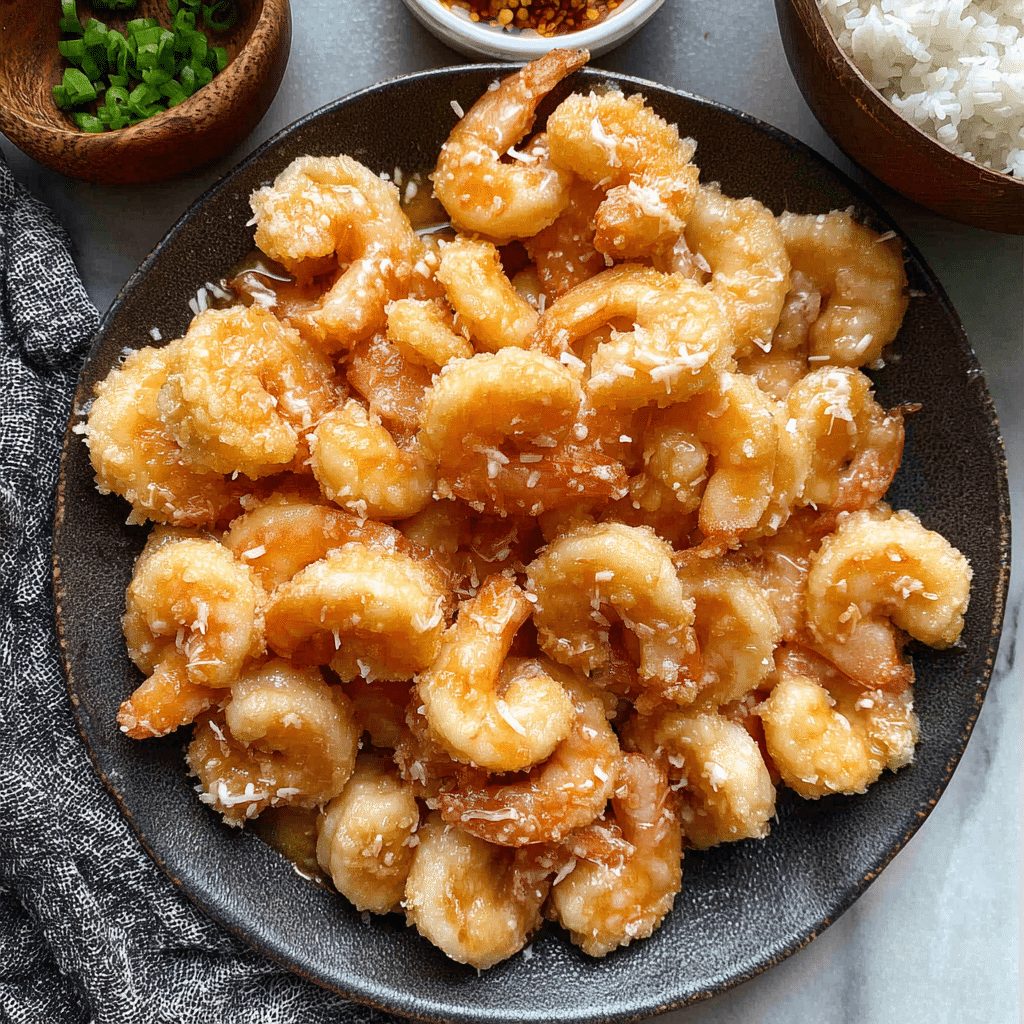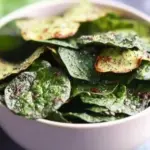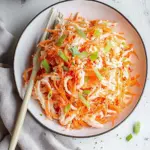This dish brings together golden‑crispy shrimp coated in a light, airy cornstarch crust that clings perfectly to a luscious coconut‑milk sauce. It’s reminiscent of classic Chinese buffet flavors, but so easy to make at home. What makes it truly stand out is the surprise richness from just a tablespoon of mayonnaise in the sauce—totally undetectable but utterly creamy.
Whether you’re cooking for a small family dinner or feeding a crowd, its combination of crunchy sweetness and silky coconut sauce never fails to impress. Serve it hot off the stove so the crust stays crisp and the sauce clings deliciously with every bite.
Full Recipe
Ingredients:
-
1 lb shrimp (peeled & deveined)
-
1 large egg white
-
2 tbsp water or Chinese rice wine
-
1 tsp salt
-
1 cup cornstarch
-
1 tsp baking powder
-
For coconut sauce: ¾ cup full-fat coconut milk, ¼ cup sugar, 1 tbsp mayonnaise, 1 tsp white vinegar, 1½ tsp cornstarch, ¼ tsp salt, 1 tsp neutral‑flavored oil, 1 tsp minced ginger
Directions:
-
Marinate shrimp with egg white, water (or rice wine), and salt for 10–15 min.
-
Stir together cornstarch and baking powder for breading. Sprinkle ¼ cup of mixture on tray.
-
Dredge each shrimp in breading, let rest 10 min.
-
In a small pot, sauté ginger in oil 30 sec over medium heat. Add coconut sauce ingredients, simmer until thickened; set sauce aside on lowest heat.
-
Heat about 1 inch of neutral oil to about 350 °F in a deep skillet or Dutch oven. Fry shrimp in batches for 1–2 min until golden and crispy. Drain shrimp on wire rack.
-
Toss crispy shrimp in warm coconut sauce until fully coated. Serve immediately.
Prep Time: 25 minutes | Cooking Time: 10 minutes | Total Time: 35 minutes
Kcal: approx. 360 kcal | Servings: 4
Introduction to Chinese Coconut Shrimp
Chinese Coconut Shrimp is a dish that combines the crispy texture of lightly battered and fried shrimp with the rich, sweet, and creamy flavor of a coconut-based sauce. It’s a recipe that feels indulgent yet approachable and is beloved for its comforting blend of textures and flavors. Unlike more traditional shrimp dishes, this version delivers a balance of sweetness and umami, making it stand out on any dinner table. Commonly found in Chinese buffet spreads across North America, it has earned a reputation as a go-to comfort food with an exotic flair.
A Fusion of Sweet and Savory
What makes this dish particularly unique is the combination of Eastern cooking techniques with Western-style creamy sauces. While coconut milk is a common ingredient in many Asian cuisines, its use in a thick, sweet sauce with mayonnaise, sugar, and vinegar creates a flavor profile that’s almost dessert-like but still undeniably savory. This fusion is precisely why this recipe remains a standout—especially when served fresh with a crispy exterior that contrasts beautifully with the velvety sauce. It’s a wonderful example of how traditional and modern ingredients can come together to form something both familiar and novel.
Origins and Cultural Influence
Though you won’t often find Coconut Shrimp served in traditional Chinese homes, the dish has become an integral part of Chinese-American cuisine. It likely emerged as a Westernized adaptation of fried shrimp dishes to appeal to American palates in the buffet-style dining era of the 1980s and ’90s. It captures the spirit of what many associate with Chinese takeout: fast, flavorful, and satisfying. Over time, different regions and restaurants have added their own twists, whether through garnish, sauce adjustments, or presentation, but the core idea remains: crispy shrimp coated in a luscious, sweet coconut sauce.
The Secret Behind the Sauce
The heart of this dish is the sauce. Unlike typical dipping sauces, the coconut sauce in this recipe is warm, cooked, and slightly thickened so that it can coat the shrimp rather than simply sit on top. The use of full-fat coconut milk brings richness, while a small amount of mayonnaise adds body and smoothness. A touch of sugar enhances the sweetness, and vinegar cuts through the richness, balancing the sauce so it doesn’t overwhelm the crispy shrimp. A hint of ginger brings aromatic warmth, making every bite feel layered and satisfying.
Perfect Texture and Frying Technique
Achieving that iconic crispy shrimp coating is all about the dredging process and fry timing. This recipe uses a cornstarch and baking powder mixture that yields a light yet crunchy coating that doesn’t get soggy too quickly. The shrimp are dredged evenly and allowed to rest briefly before frying, ensuring a solid crust forms. Cooking them in hot oil—ideally around 350°F—for just a minute or two locks in their juiciness while turning the exterior golden brown. The short cooking time also prevents the shrimp from becoming rubbery, preserving their natural tenderness.
Presentation and Serving Suggestions
Visually, Chinese Coconut Shrimp is stunning when plated properly. The contrast of golden shrimp coated in glossy white sauce makes for an elegant presentation. For extra flair, many like to garnish it with shredded coconut, chopped green onions, or even a few red pepper flakes for heat. It pairs well with steamed jasmine rice or fried rice, and fresh vegetables like snow peas or bok choy can add color and crunch to the meal. For a more Western twist, serve it over a light salad or in lettuce cups for a fusion-style appetizer.
Why It’s a Crowd-Pleaser
This recipe is perfect for entertaining. Whether you’re hosting a dinner party or just want a fun weeknight meal, coconut shrimp feels a little special. It’s also extremely kid-friendly thanks to its mild flavors and lightly sweet sauce. Adults love it for the depth and nostalgia—it’s often one of those dishes people remember from buffet visits or special nights out. Because it’s both elegant and easy to prepare in batches, it’s also a great option for potlucks, family gatherings, and even holiday menus.
Make-Ahead Tips and Variations
Although best served fresh, parts of this dish can be prepped in advance. The sauce can be made ahead and reheated gently before tossing with the fried shrimp. The shrimp can be marinated and dredged earlier in the day, and then fried just before serving to maintain crispness. For a healthier version, you can try air frying or baking the shrimp, though the texture will differ slightly. You can also swap in other proteins like chicken or tofu for a vegetarian variation, or add pineapple chunks and bell peppers to the sauce for a tropical twist.
Nutritional Perspective
Though this dish isn’t particularly low in calories due to frying and the richness of the sauce, it can be part of a balanced meal when enjoyed in moderation. Shrimp is a lean source of protein, low in fat and calories, and packed with nutrients like selenium and vitamin B12. The coconut milk and mayonnaise add healthy fats, and you can always adjust the amount of sugar or substitute it with a natural sweetener to lighten the sauce. When paired with vegetables or a whole grain like brown rice, it becomes a satisfying and well-rounded meal.
The Role of Coconut in Asian Cooking
Coconut is used in countless Asian recipes, especially in Southeast Asia, where it appears in both savory dishes and desserts. Its creamy consistency and naturally sweet flavor make it a versatile ingredient. In Chinese cuisine, coconut is less common but often appears in sweets like coconut buns or desserts with tapioca. This shrimp recipe bridges a cultural gap by introducing coconut’s sweetness into a savory, crispy main course. It’s this unexpected use of coconut that makes the dish both interesting and memorable.
Conclusion
Chinese Coconut Shrimp is more than just a buffet favorite—it’s a flavorful fusion dish that combines texture, richness, and cultural adaptability. Its crispy coating and sweet coconut sauce make it a comfort food that transcends generations and dining styles. Whether you’re recreating your favorite restaurant dish at home or introducing your family to something new, this recipe delivers satisfaction in every bite. It’s proof that with a few simple techniques and the right ingredients, you can bring restaurant-quality flavor into your kitchen with ease.
Its universal appeal lies in its perfect balance of sweet, savory, and crunchy, making it a hit every single time. And while it pays homage to American-Chinese culinary traditions, it’s also a canvas for creativity and personalization. Add this one to your rotation—it just might become your new weeknight favorite or your most requested dinner party dish.






